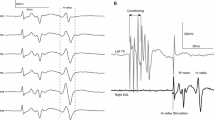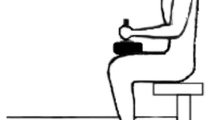Abstract
Changes in the reflex amplitude throughout the day have been observed in non-human mammals. The present experiment tested whether diurnal fluctuations also occur in humans. Hoffmann reflex (H-reflex) amplitude was measured in soleus and flexor carpi radialis (FCR) muscles from the data collected over a 12-h period between 7:00–9:00 a.m. and 7:00–9:00 p.m. At 4-h intervals, M/H recruitment curves were obtained, and two measures of H-reflex excitability were calculated. The maximal H-reflex (H max) was calculated as the average of the three largest H-reflexes. H-reflexes were also sampled from the ascending limb of the M/H recruitment curve (H A, n=10), with a corresponding M-wave of 5% M max. All values were normalized to the maximal M-wave (M max). Soleus H-reflex amplitude and plantar flexion maximal voluntary isometric contraction force (MVIC) were significantly smaller (p<0.05) in the morning (H max=57.2% M max, H A=42.3%, M max, MVIC=162.1 Nm) than in the evening (H max=69.1% M max, a 20.1% increase, H A=54.1% M max, a 27.4% increase and MVIC=195.8 Nm, a 20.8% increase). In contrast, FCR H-reflex amplitude and FCR MVIC were unchanged across all testing sessions. The data show that diurnal fluctuations are present in the amplitude of the human soleus but not in the FCR H-reflex. Diurnal fluctuation in the human soleus H-reflex amplitude must be considered when interpreting H-reflex data, especially when a repeated measures design spanning several days is utilized.




Similar content being viewed by others
References
Carroll TJ, Baldwin ERL, Collins DF (2005) Task dependent gain regulation of spinal circuits projecting to the human flexor carpi radialis. Exp B Res 161:299–306
Chen XY, Chen L, Wolpaw JR, Jakeman LB (2002) Corticospinal tract transection reduces H-reflex circadian rhythm in rats. Brain Res 942(1–2):101–108
Chen XY, Wolpaw JR (1994) Circadian rhythm in rat H-reflex. Brain Res 648:167–170
Chen XY, Wolpaw JR (1995) Operantly conditioned plasticity and circadian rhythm in rat H-reflex are independent phenomena. Neurosci Lett 195:109–112
Cohen J (1988) Statistical power analysis for the behavioral sciences, 2nd edn. Lawrence Earlbaum Associates, Hillsdale, NJ
Dowman R, Wolpaw R (1989) Diurnal rhythms in primate spinal reflexes and accompanying cortical somatosnesory evoked potentials. Electroencephalogr Clin Neurophysiol 72:69–80
Gauthier A, Davenne D, Martin A, Van Hoecke J (1996) Diurnal rhythm of the muscular performance of elbow flexors during isometric contractions. Chronobiol Int 13:147–158
Kalsbeek A, Ruiter SE, la Fleur C, Van Hejningen Buijs RM (2003) The diurnal variation of hormonal responses in the rat varies with different stimuli. J Neuroendocrinol 15:1144–1155
Loram ID, Maganaris CN, Lakie M (2005) Active, non-spring-like muscle movements in human postural sway: how might paradoxical changes in muscle length be produced? J Physiol 564:281–293
Martin A, Carpentier A, Guissard N, Van Hoecke J, Duchateau J (1999) Effect of time of day on force variation in human muscle. Muscle Nerve 22:1380–1387
Misiaszek JE (2003) The H-reflex as a tool in neurophysiology: its limitations and uses in understanding nervous system function. Muscle Nerve 28(2):144–160
Morita H, Petersen N, Christensen LO, Sinkjaer T, Nielsen J (1998) Sensitivity of H-reflexes and stretch reflexes to presynaptic inhibition in humans. J Neurophysiol 80:610–620
Rosnow RL, Rosenthal R (1996) Computing contrasts, effect sizes, and counternulls on other people’s published data: general procedures for research consumers. Pyschological Methods 1:331–340
Stephan FK, Zucker I (1972) Circadian rhythms in drinking behaviour and locomotor activity of rats are eliminated by hypothalamic lesions. Proc Nat Aca Sci USA 69:1583–1586
Walton C, Kalmar J, Cafarelli E (2003) Caffeine increases spinal excitability in humans. Muscle Nerve 28(3):359–64
Wolpaw JR, Seegal RF (1982) Diurnal rhythm in the spinal stretch reflex. Brain Res 244:365–369
Wolpaw JR, Noonan PA, O’Keefe JA (1984) Adaptive plasticity and diurnal rhythm in the primate spinal stretch reflex are independent phenomena. Brain Res 300(2):385–391
Zehr EP (2002) Consideration for the use of the Hoffman reflex in exercise studies. Euro J App Physiol 86:455–468
Author information
Authors and Affiliations
Corresponding author
Rights and permissions
About this article
Cite this article
Lagerquist, O., Zehr, E.P., Baldwin, E.R.L. et al. Diurnal changes in the amplitude of the Hoffmann reflex in the human soleus but not in the flexor carpi radialis muscle. Exp Brain Res 170, 1–6 (2006). https://doi.org/10.1007/s00221-005-0172-1
Received:
Accepted:
Published:
Issue Date:
DOI: https://doi.org/10.1007/s00221-005-0172-1




